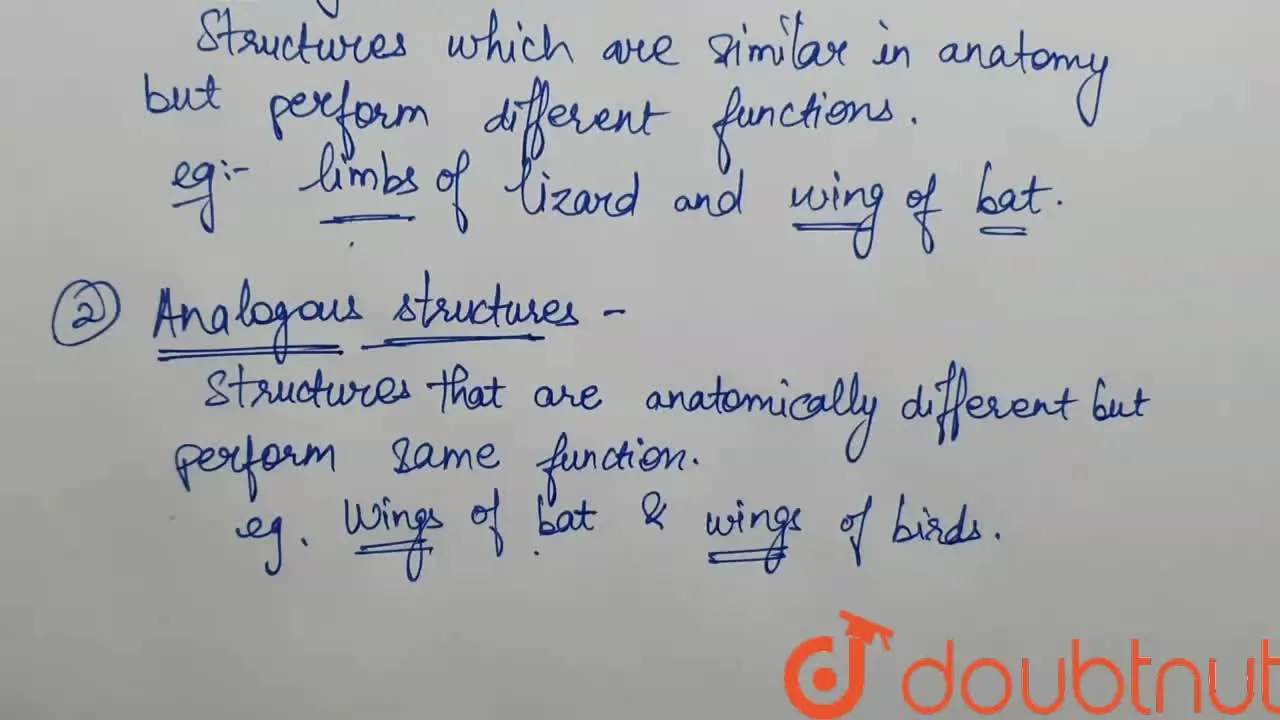Explain morphological and anatomical evidences of organic evolution.Solution in Punjabi
1. Homology and analogy. The organs of similar structure and origin but dissimilar in function and form are called as homologous organs and this phenomenon is called homology. The presence of homologous organs implies a common evolutionary origin of amphibians, reptiles, birds and mammals from some ancient fish ancestor. The homologous structures seen in successive generations indicate actual relationship and the possessors are the diverse descendants of common ancestry (Divergent evolution).
The organs that perform the same function but differ in their origin and structure, are called as analogous organs and the phenomenon is called analogy. The wings of an insect are analogous to those of birds and bats because they perform the same function but have dissimilar structure and origin. The wings of an insect are modified outgrowth of the body wall whereas wings of birds and bats are modified forelimbs. These organs have arisen in evolutionary process through adaptation of quite different organisms to a similar mode of life (Convergent evolution).
On the same line, the similarities in proteins and genes performing a given function among diverse organisms give clues to common ancestry. These biochemical similarities point to the same shared ancestry as structural similarities among diverse organisms.
2. Vestigial organs. These are the reduced and functionless organs which are of no use to the possessor but they still persist generation after generation in reduced form in an individual. They were complete and functional in the ancestors e.g., appendix in man is considered as the remnant of large intestine (caecum) but it is considered to be storage organ for cellulose digestion in herbivorous mammals. The vestigial organs reveal a strong evidence for evolution. They are the remnants of organ which used to perform a normal function in the ancestor but during the course of evolution, they have been reduced to vestiges.
3. Atavism. It is reappearance of ancestral characters other than parents in the newly born offspring, which have either completely disappeared or reduced. The reappearance of short tail in some Babies, multiple mammae in some individuals and dense hairy body etc, are the example of atavism. The reappearance of such ancestral characters favour evolution.
4. Connecting links. The organisms which possess the characters of two different groups of organisms are known as connecting links e.g. Duck-billed platypus and Spiny ant-eater serve as a connecting link between the mammals and reptiles. Similarly, lung fishes (Protopterus) is a connecting link between fishes and amphibians.
Related Playlists
- BOOK - BETTER CHOICE PUBLICATIONCHAPTER - EVOLUTION EXERCISE - LONG ANSWER TYPE QUESTIONS (5 Marks) (MOST EXPECTED QUESTIONS)13videos
EVOLUTION
- BOOK - BETTER CHOICE PUBLICATIONCHAPTER - EVOLUTION EXERCISE - SHORT ANSWER TYPE QUESTIONS (3 Marks) (MOST EXPECTED QUESTIONS )9videos
EVOLUTION
- BOOK - BETTER CHOICE PUBLICATIONCHAPTER - ENVIRONMENTAL ISSUES EXERCISE - LONG ANSWER43videos
ENVIRONMENTAL ISSUES
- BOOK - BETTER CHOICE PUBLICATIONCHAPTER - HUMAN HEALTH AND DISEASEEXERCISE - LONG ANSWER TYPE QUESTIONS (MOST EXPECTED QUESTIONS)12videos
HUMAN HEALTH AND DISEASE
Similar Questions
Explain Human Evolution.
View SolutionWho proposed the theory of origin of life? What were the conditions prevailing about 3.6 billion years ago, to create life on primitive earth ?
View SolutionDiscuss the causes of global warming. What measures need to be taken to control global warming?
View SolutionWrite the causative organism, mode of infection, symptoms and preventive measures of the disease pertussis.
View SolutionExplain with suitable examples importance of anatomical evidences in evolution.
View SolutionExplain with suitable examples importance of anatomical evidences in evolution.
03:11View SolutionWhat is morphological evidence of evolution?
03:03View SolutionExplain with sutibale examples importance o anatomical evidences in evolution.
03:12View SolutionExplain with suitalble examples importance of anatomical evidences in evolution.
01:27View SolutionExplain with suitable examples importance of anatomical evidences in evolution.
03:02View SolutionExplain in detail with diagrams, the evidences of evolution, through morphology and anatomy.
05:49View SolutionExplain three morphological evidences in support of evolution.
01:07:37View SolutionPeripatus: Connecting link:: Wisdom tooth: ____________ options a)morphological evidence b)Embryological evidence c) vestigial organ d) anatomical evidence
01:45:15View SolutionWhat is morphological evidence of evolution?
01:02:38View SolutionHow do morphological and anatomical evidences support organic evolution? Explain with examples.
01:10:57View SolutionEvidences OF Organic Evolution || Evidences From Comparative Morphology and Anatomy || Homology ( Divergent Evolution+ Adaptive Radiation) || Analogy (Convergent Evolution + Adaptive Convergence)
02:50View Solution


